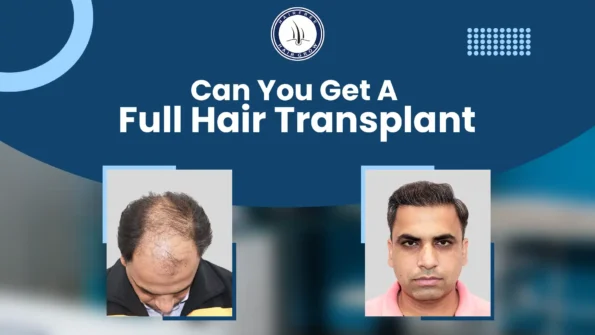Hair transplants are a great option for many people, but what if you’re completely bald? It might seem like you’re out of luck, but that’s not always true. Learn how a full hair transplant can restore your hair and confidence.
Hair transplants use hair follicles from another part of your scalp to fill in bald spots. Normally, doctors take hair from the back of the head where it’s strong and less likely to fall out. But if you’re totally bald, there might not be enough hair there to use.
Don’t worry though! In some cases, there are still options. Here’s the short answer:
- Maybe: If you have some leftover hair on the back of your scalp, a transplant might still be possible.
- Yes, but different: If you’re completely bald, doctors might be able to take hair follicles from other parts of your body, like your beard, to transplant to your head.
Talk to a doctor to see if a hair transplant is right for you, even if you’re completely bald. There might be ways to get your hair back!
Can You Get A Hair Transplant If You Are Completely Bald?
Even if someone is completely bald, they can still get a hair transplant. That means if you’ve lost a lot of hair, you can have a surgery to get some of it back.
But here’s the thing: don’t expect to walk out of the surgery with a full head of hair like a movie star. The goal is usually to make your hairline look more natural.
So yes, you can get a hair transplant even if you’re totally bald, but manage your expectations – you probably won’t get a super thick head of hair, just a more natural-looking one.
How Many Hair Grafts Are Needed to Cover a Fully Bald Head?
To cover a fully bald head with a hair transplant, you would typically need between 5,000 to 6,000 hair grafts, or possibly even more. This process can be quite challenging as the surgeon needs to carefully consider the safe donor area from which the hair grafts are harvested. The goal is to achieve a natural and dense look in both the crown and hairline areas.
At the most advanced stage of hair loss, which is not specifically defined on the Norwood Scale, around 4,000 grafts may be required to create a fuller appearance on the head. It’s important for the surgeon to assess the donor area’s capacity for harvesting to ensure a successful and aesthetically pleasing outcome.
How Bald is Too Bald for a Hair Transplant?
When it comes to determining if you are too bald for a hair transplant, the Norwood Scale is often used to assess the extent of male pattern baldness. This scale categorizes hair loss into 7 stages, with stage 7 representing the most advanced level of baldness where there is typically a band of hair around the sides and back of the head, but baldness across the crown. Stage 6 on the Norwood Scale can also show significant baldness.
In some cases, men may experience hair loss even in the safe donor area on the back and sides of the scalp, known as retrograde alopecia. If you are completely bald, you may be beyond the stages defined by the Norwood Scale.
However, being totally bald does not necessarily rule out the possibility of a hair transplant. It is still possible to have visible hair follicles in other donor areas of the body that can be used for the transplant procedure.
During a hair transplant, surgeons carefully consider the availability of hair grafts from the safe donor area to avoid overharvesting follicles. This ensures a safe and effective transplant outcome. So, even if you have some remaining hair, its usability for transplantation depends on whether it is located in the safe donor area.
How We Can Help With Hair Loss
If you’re struggling with hair loss and it’s affecting your confidence, Hairfree Hairgrow Clinic is here to support you. After consulting with your doctor to address any underlying issues, you can begin exploring options for hair restoration. This may involve discussing hair transplant procedures or considering medications to help combat further hair loss.
With over 10 years of experience, Hairfree Hairgrow Clinic offers expert hair restoration services. Our dedicated team provides top-notch care, and our Trichology experts are available to address any queries and assist you throughout your hair restoration journey.
Schedule a free consultation with our team to learn more and discover the essential questions to ask before undergoing hair transplant surgery. This will help you make the most out of your consultation and make informed decisions about your hair restoration options.
Written By
MD (Skin & VD)
Dr. Chintan Bhavsar is a renowned hair restoration specialist with expertise in full hair transplants. He provides personalized solutions to patients seeking complete hair restoration, ensuring natural results and effective outcomes for a confident appearance and improved hair health.
Disclaimer
We’ve made all possible efforts to ensure that the information provided here is accurate, up-to-date and complete, however, it should not be treated as a substitute for professional medical advice, diagnosis or treatment. See Detailed Disclaimers Here.




